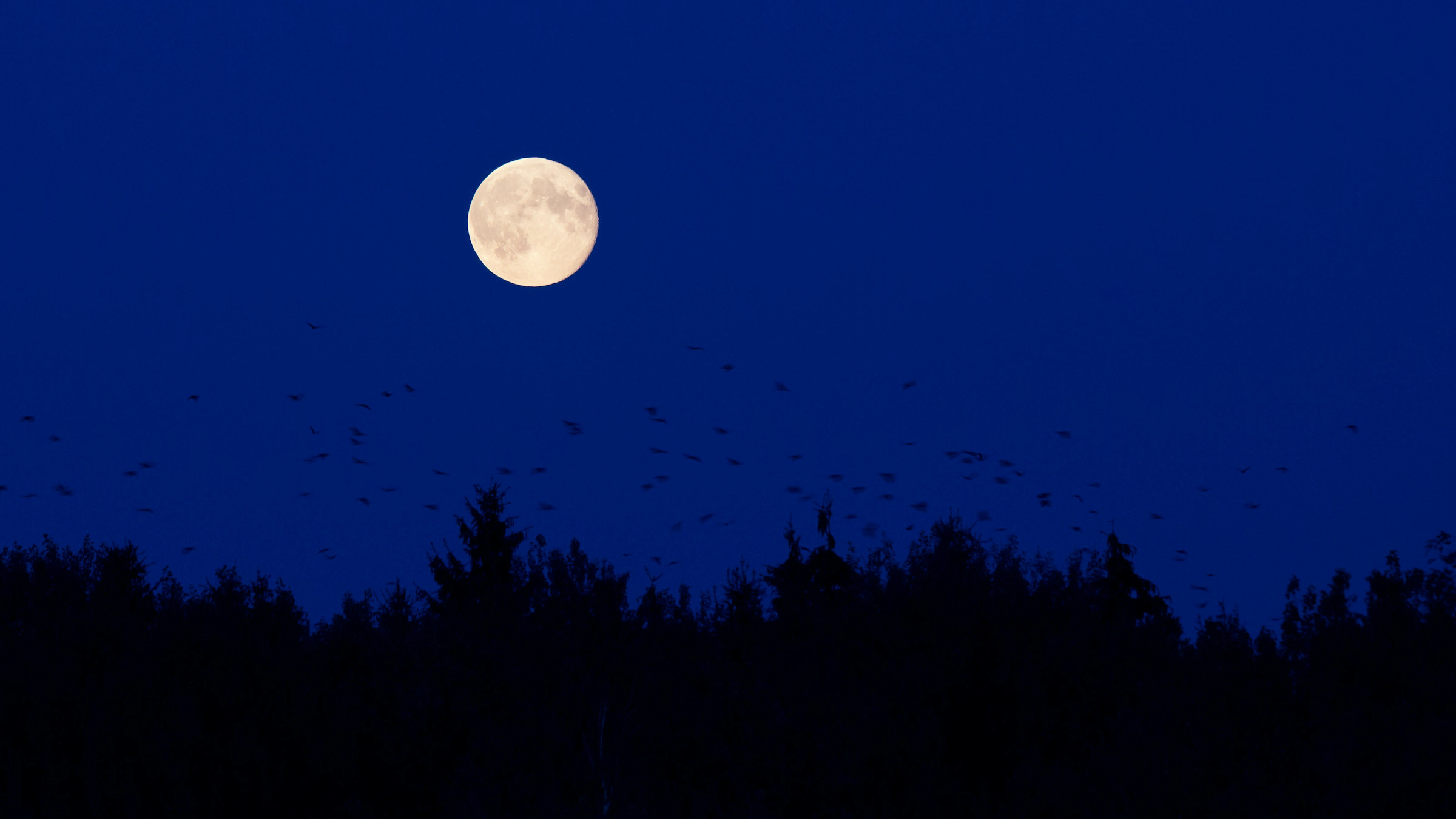How to see October's full Hunter's Moon (and the Orionids) tonight
The Orionid meteor shower peaks the same day.

The full moon this week will spill pale light onto October's spookily-carved Halloween pumpkins and autumn-hued leaves this Wednesday morning (Oct. 20).
The moon will be full at exactly 10:57 a.m. EDT (2:57 p.m. GMT) on Wednesday, when the sun, Earth and moon line up (in that order), according to NASA. Because the moon's orbit is about 5 degrees different than Earth's, it is often a bit higher or lower than Earth's shadow, which allows the sun to bathe the side of the moon facing Earth with light when there's a full moon, Andrea Jones, a science communicator at NASA, previously told Live Science in a video interview.
October's Hunter's Moon will appear full for three days, from Monday night (Oct. 18) through Thursday night (Oct. 21). Skygazers can also catch another treat; the Orionid meteor shower, peaks Wednesday, although the light from the full moon may make it hard to see the shower's "shooting stars," Space.com, a Live Science sister site, reported.
Related: 'Ring of fire' solar eclipse wows skywatchers (photos)
October's full moon is commonly known as the Hunter's Moon, whose earliest use dates to 1710, according to the Oxford English Dictionary. Hunters can find fattened animals, such as deer, at this time of year, according to the Farmer's Almanac, NASA reported.
According to the now-defunct Maine Farmer's Almanac, which, in the 1930s, reported on Native American moon names, common names for the October moon included the Travel Moon, the Dying Grass Moon and the Sanguine or Blood Moon, among the Algonquin tribes of North America, NASA reported. Some of these names likely refer to leaves changing color in autumn and the dying back of plants, whereas the Sanguine and Blood Moon reference hunting.
The Travel Moon may refer to the migration of birds and other animals getting ready for winter. "I don't know, but this name may also refer to the season when the more northern tribes would move down from the mountains for the winter," Gordon Johnston, a NASA program executive, wrote in a post. "For example, both the Iroquois and Algonquin would hunt in the Adirondacks in the summertime but would leave to avoid the harsh mountain winter."
Sign up for the Live Science daily newsletter now
Get the world’s most fascinating discoveries delivered straight to your inbox.
Meanwhile, in India, October's full moon coincides with the seasonal monsoon rains. For Hindus, this full moon marks the harvest festival Sharad Purnima. The full moon also signals the end of a three-month meditative period for Buddhist monks known as Vassa, or "rainy retreat" which is also known as the Buddhist Lent.
Scientists recently coined a new moniker for this full moon — the Lucy Moon, in honor of NASA's Lucy mission that launched on Oct. 16 and is journeying to the Trojan asteroids. These asteroids go around the sun with Jupiter, the largest planet in the solar system. Lucy will spend 12 years exploring seven of these asteroids, as well as one asteroid from the main asteroid belt that Lucy will encounter on its way, NASA reported.
As for the Orionid meteor shower, skywatchers in the Northern and Southern Hemispheres may see as many as 20 meteors per hour, Space.com reported. That's way more than the average of five meteors per hour that skygazers can see on other nights, Live Science previously reported. Meteors, colloquially known as shooting stars, are bits of space rocks that burn up in bright streaks across Earth's atmosphere. The best views for the meteor shower will be far away from city lights, but the light of the full moon will likely make it hard to see these streaking beauties.
"The Orionids are going to, frankly, suck this year ... the moon will be up all night, from sunset to sunrise," NASA meteor expert Bill Cooke told Space.com.
The Orionid meteors come from the shed pieces of Comet 1P/Halley, more famously known as Halley's Comet, which swings by Earth every 75 years or so. The meteor shower appears to come from the constellation of Orion, the hunter, which is how the shower got its name. The best time to see the meteor shower is around 2 a.m. local time Oct. 20, but if you miss the peak, you can still catch the meteor shower until it dwindles in late October, Cooke told Space.com.
Originally published on Live Science.

Laura is the archaeology and Life's Little Mysteries editor at Live Science. She also reports on general science, including paleontology. Her work has appeared in The New York Times, Scholastic, Popular Science and Spectrum, a site on autism research. She has won multiple awards from the Society of Professional Journalists and the Washington Newspaper Publishers Association for her reporting at a weekly newspaper near Seattle. Laura holds a bachelor's degree in English literature and psychology from Washington University in St. Louis and a master's degree in science writing from NYU.










